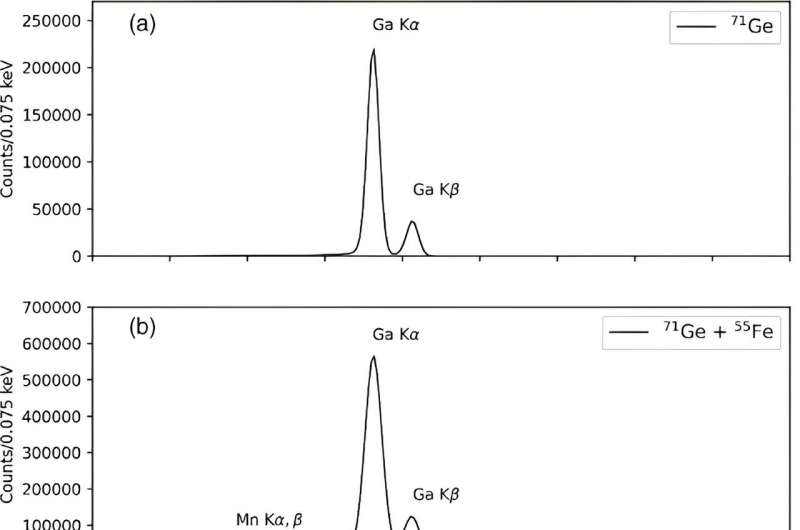
JUNE 5, 2024 by Anne M. Stark, Lawrence Livermore National Laboratory
Collected at: https://phys.org/news/2024-06-germanium-isotope-day-life.html
Searching for the elusive neutrino takes on many forms. Detectors consisting of many tons of gallium are used in several experiments because neutrino interactions can occur on the stable gallium-71 (71Ga) nucleus and transform it into a radioactive isotope of germanium (71Ge) with an 11-day half-life that can then be observed with traditional radiation detectors.
However, the rate of 71Ge production from these interactions has been observed to be short of expectations. This has emerged as what is referred to as “the galliumanomaly“—a significant discrepancy that occurs when electron neutrinos bombard gallium and produce the 71Ge.
This anomaly cannot be explained by current theories. As a result, it has given rise to speculation that it could be a signature that the neutrino can transform into other exotic particles, such as sterile neutrinos, which interact even less with matter than a normal neutrino; if confirmed, this would be a massive discovery.
Recently, a suggestion was made that this anomaly could instead be explained by something more mundane—a mismeasured half-life for the 71Ge nucleus. This is because the predicted rate of neutrino interactions depends on this half-life.
To test this possible explanation of the gallium anomaly, a team of scientists from Lawrence Berkeley and Lawrence Livermore national laboratories have determined the 71Ge half-life with a set of carefully performed measurements including two performed side-by-side with other long-lived radioactive isotopes with well-known half-lives. The research appears in Physical Review C.
The team was able to pin down the 71Ge half-life to a precision about four times better than any previous measurement. The work eliminates the mismeasurement of 71Ge as an explanation for the anomaly, which thus must have a different origin—possibly in the existence of a fourth neutrino type, called a sterile neutrino.
“The new half-life obtained by our team confirmed the earlier results, but put it on much firmer footing, definitively ruling out the possible explanation that the missing neutrinos were instead due to an incorrect 71Ge half-life,” said LLNL scientist and lead author Nick Scielzo. “Therefore, the gallium anomaly remains a true mystery—one that potentially still requires some kind of unexpected new neutrino behavior to understand.”
The study’s other LLNL authors include Narek Gharibyan, Ken Gregorich, Brian Sammis, Jennifer Shusterman and Keenan Thomas.
More information: E. B. Norman et al, Half-life of Ge71 and the gallium anomaly, Physical Review C (2024). DOI: 10.1103/PhysRevC.109.055501. On arXiv: DOI: 10.48550/arxiv.2401.15286
Journal information: Physical Review C , arXiv

Leave a Reply